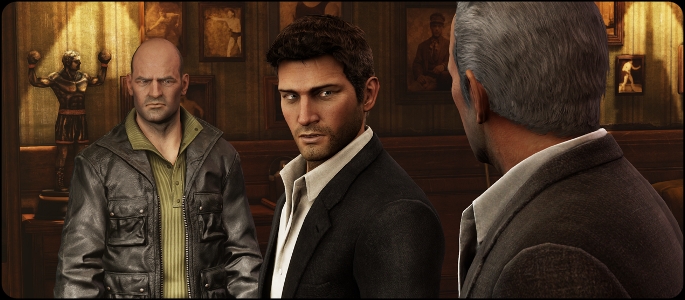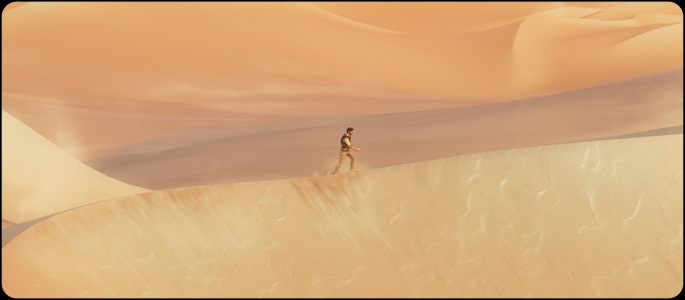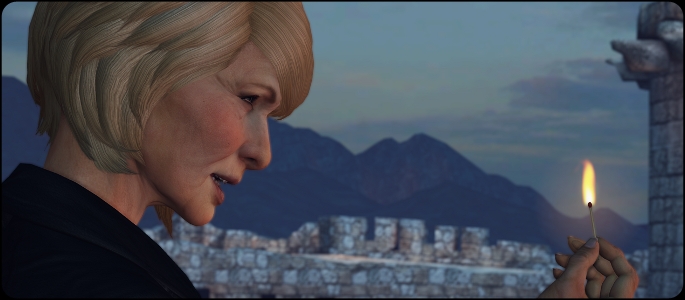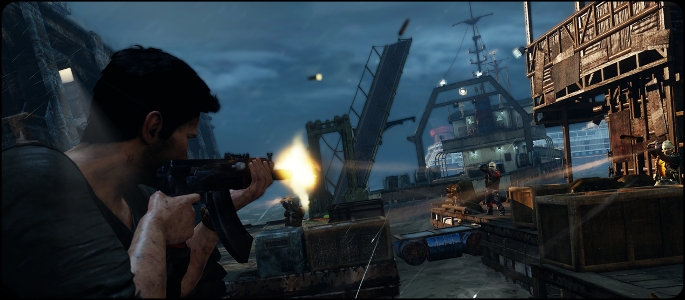With Uncharted 2: Among Thieves getting almost unanimous Game of the Year nods throughout the entire game industry in 2009, Naughty Dog set its own bar extremely high going into a third game. Expectations more pressing and competition being fiercer than ever, is Uncharted 3: Drake’s Deception the perfect game that everyone has been waiting for?
It’s not easy to compete with perfection – Naughty Dog’s biggest competition may very well be itself. Having crafted a near perfect game in Uncharted 2, the group will not only have to deal with the likes of Skyrim and Batman: Arkham City, but they’ll have to make everything that was so great about Uncharted 2 even better.
If it ain’t broke, don’t fix it. Like Uncharted 2, Drake’s Deception‘s biggest highlight is in the cinematic presentation. Every second of the single-player campaign from start to finish has the makings of a blockbuster summer action flick. From love stories, to edge-of-your-seat cliffhangers, to emotional rollercoasters, Uncharted 3 has it all. And at times, it can handily compare with some of the best that Hollywood’s ever produced.
“Uncharted 3 can handily compare with some of the best that Hollywood’s ever produced.”
–
The story behind the ring–Sir Francis Drake’s ring–that Nathan Drake wears around his neck is told through over 20 chapters, a number of real-life geographical locations and about eight to ten hours of action, drama and adventure. Along with finding out the true origins of the ring and its purpose, Uncharted 3 fills in the blanks on some back story as well as the events that took place after the crew stopped Lazarevic in Shambhala. After learning more about the characters, they begin to feel more like real people. There’s an emotional connection between these characters that you can feel, and it makes all of what they’re fighting for seem right.

It helps that each character is voiced by series and industry veterans who know how to bring polygons to life. The dialog is constant and witty. The banter between cast members feels incredibly natural and helps to make the rest of the script all the more entertaining. The accompanying story has enough fiction based on historical facts that it’s believable (to a point), but is still filled with wonder and the tingling of excitement. And it’s all executed so well — the highs reach crazy heights and the lows will tug on heart-strings you didn’t even know you had.
The gameplay is as satisfying as the fantasy. Shooting and ducking for cover is as fluid as ever, but this dog has learned some new tricks, too. Hand-to-hand combat is much more deep, and as such, there’s a stronger focus on it. Drake has learned some new melee and stealth attacks, but it’s in the midst of fisticuffs where the combat shines. Counterattacking is imperative as the enemy AI is in constant attack mode, and Drake can now toss an enemy in any direction to set up for additional attacks. New enemies called brutes require a barrage of different attack strategies. At first, brutes act as a clever way to distract from gunplay and force the new combat techniques, but eventually turn to feeling too scripted and prosaic.
Other mechanics, like climbing, grabbing ledges, jumping, or giving chase, are utterly flawless in performance. Each area is designed to take advantage of Drake’s full range of abilities; there’s always a conveniently placed path up the side of a building whose door just so happens to be locked. A lot of traversal opportunities for Drake are on the far-fetched side, but without them, the game wouldn’t be as enjoyable. There is, however, one moment where Drake is mid-air (that’s all I’ll say as not to spoil anything) that went too far with our hero’s fortuity.

Despite at times appearing invincible and cocky, this adventure eventually takes its toll on Drake. Especially in the latter part of the game, the challenges Drake faces are enough to wear even the strongest of mind and body. The dry, barren, scorching desert stand is only one such adversary that Drake must overcome. The elements literally weather the young fortune hunter to the point of exhaustion. Water, fire and sand effects are better than any other game… ever. Nothing even comes close to touching how realistic it looks and feels.
“Water, fire and sand effects are better than any other game… ever.”
–
Drake’s foes are more dangerous than before. Rather than a villain that remains faceless until the final showdown, Katherine Marlowe and her crony Talbot remain a thorn in Drake and Co.’s side from the game’s first scene (and even earlier than that) until the credits roll. She’s a wealthy, wrinkled collector of rare artifacts and treasure who is hell-bent on getting Sir Francis Drake’s ring. Talbot is her British cockney-accented hired bodyguard that doesn’t want to die – no matter how many bullets you seem to put into him. The duo is inherently evil, and are Drake’s worthiest and most capable adversaries yet.

Marlowe and Talbot are the ugly side of Uncharted 3, everything else is stunning. The amount of detail that goes into every environment, every texture–absolutely everything in the game–is truly amazing. The view of Drake’s surroundings and backdrops can be such a sight to behold, that you simply must stop at times to do nothing more but gaze at the screen. And, just like a Hollywood blockbuster movie, the camera is perfectly positioned to give you the best look at all the work Naughty Dog has put into the game. The inclusion of 3D makes everything pop in all the right places, gives depth to the lush environments, and heightens the visual experience.
The Chateau level and the later desert levels are bright and beautiful. It’s not that the other levels aren’t well-designed and brimming with detail, it’s that they’re meant to look darker and dirty – not every locale is a sunny paradise, after all. The brighter levels are where a point for owning a 3DTV can really be made, but darker areas, while still having that “pop,” don’t have quite the same impact on the view. Terrain varies greatly, from the brush-filled jungle settings you’re used to, to deeply settled foreign markets, to sea-worn and rusted industrial shipyards.

Character models, especially faces, are photo-realistic. You can see every grain of stubble on Drake’s unshaven face. Body movement is very natural due to all the subtle touches implemented; things like a hand grazing a wall as Drake passes by help to make the characters come to life. Facial expressions convey the emotional impact of a situation, be it a smile in the wake of a happy homecoming, or a wrinkle of deceit in the brow of your enemy.
Real-life themes are ever-present throughout. There are relationship struggles between the cast; at times Drake must call his most-trusted friends into question, and even doubts his own judgment. At the end, it all clicks, and Drake realizes who his true friends are. The end itself brings some real closure to the trilogy, but lacks a certain feeling of “finale” and is missing a “real” final boss battle.
“…it’s so good that you will want to go back for seconds, even thirds.”
–
When it’s all said and done, it’s so good that you will want to go back for seconds, even thirds. There are 100 treasures to be collected, too, all strewn about various areas of the game. Most are out in the open, others are in difficult to spot–and reach–areas. Crushing difficulty poses a serious challenge to even the most hardened of fortune hunters. As with all single-player focused games, there’s only so many items to collection and only so many times you can play through a campaign. But Uncharted 3 has plenty of life left beyond the eight to ten hours of cinematic, blockbuster action and adventure.
Next Page: Multiplayer and Conclusion »
Pages: 1 | 2 |








